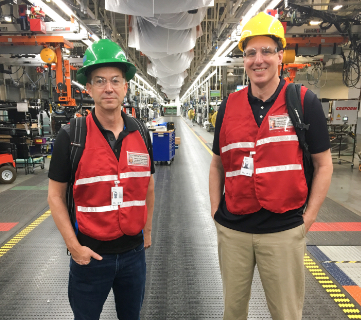Diamond Grading
Diamond graders have preferred Dazor fluorescent lighting for decades for their ease of use and high quality lighting options.
As we know, the lighting environment in which diamonds are purchased, sold, sorted, and graded is critical. The same diamond responds differently in different lighting conditions, so the consistency and repeatability of the lighting environment is essential throughout the entire trade channels from supply to laboratory to retail selling. When possible, a diamond buyer should view a diamond in the same lighting conditions as a diamond seller, and both the buyer and seller should view diamonds in a lighting environment which closely matches that of a laboratory from which an appraisal will be issued.
For those in the trade, a diamond is viewed indoors under controlled lighting conditions in order to observe its true body color. It is not examined in outdoor lighting where its color can be influenced by the rays of the sun. In such a case, the diamond color can be improved because of a reaction between ultraviolet wavelengths and nitrogen atoms within a diamond which ordinarily may be perceived as a yellow hue. The brightness from the sun can also oversaturate subtle characteristics of the stone.
Not All Artificial Lighting is Equal
Different lighting technologies each have their own energy emissions and wavelengths. And each produces different results when viewing diamonds. Lighting that is too strong may oversaturate a stone with brightness, overpowering its true body color. Lighting that emits too much ultra-violet energy may cause a diamond’s subtle color to change and be perceived differently. Therefore using lighting technologies different than those prescribed by accepted global trade authorities promotes inconsistencies in results and affects trade integrity.
Discoloration of plastic base due to UV emitted from 36-Watt 4-pin CFL Fluorescent Bulb
Industry Standards for Lighting
Just as sunlight can affect how a diamond is perceived and graded, so can indoor artificial lighting. For the trade, promoting and preserving the integrity of diamond grading is done by producing consistent and repeatable results no matter the location anywhere in the world. That is why GIA, CIBJO, the AGA and other international authoritative bodies have established standards for the artificial lighting environments in which diamonds are to be graded.
Comparison and Compliance of Lighting
The GIA, CIBJO, AGA, and other global trade authorities have published standards for the lighting environment to be used when viewing and grading diamonds. In its Winter 2008 Gems & Gemology publication, the GIA described the lighting environment they use for color grading. Standard lighting conditions are essential because too much light "prevails over the true body color of the stone", while too much ultra-violet may cause a "fluorescent diamond whose true color appears slightly yellowish to appear slightly bluish".
Below is a table comparing lamps supplied in different fixtures for grading diamonds. The lighting variables compared are lux (quantity of light on the object being viewed should be between 2000 – 4500 lux), UV-A (long wave ultraviolet energy which commonly affects diamond color) and bulb length (430mm or longer as specified by GIA). All measurements are taken at 228mm, the approximate grading distance used by GIA.
Summary Findings
The measurements show the FT36DL (36W) and FT55DL (55W) 4-pin compact fluorescent bulbs produce quantities of light and UV energy that exceed industry guidelines. When 2 of these bulb types are used in a single fixture, the lighting environment created contains energy greatly exceeding recommended amounts for viewing diamonds. Therefore, the user of such light source may experience unanticipated and costly inconsistencies when buying or selling diamonds, or when independently appraised by a reputable laboratory.
About Dazor
Dazor Manufacturing Corp. has designed and manufactured lighting systems for the global jewelry and gemological marketplace since 1938. Its products are found in diamond bourses, manufacturing sites, in retail settings and gemological laboratories around the world. Dazor products incorporate lighting technologies that produce energy prescribed for grading by global trade authorities. Its products are sold through the most reputable distributors and dealers on each continent.
Stan Hogrebe is the President & CEO of Dazor. During 2009-2010 Mr. Hogrebe served as Chair to the Accredited Gemologist Association’s Task Force on Lighting and Color Grading Diamonds. The Task Force was comprised of gemological experts from around the world. Task Force research, findings and conclusions are located on the Accredited Gemologist Association website as follows:
http://accreditedgemologists.org/pastevents/2009Tucson.php
http://accreditedgemologists.org/pastevents/2010Tucson.php




